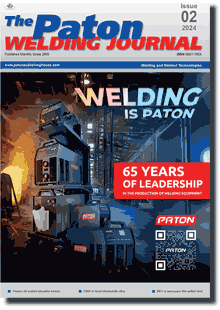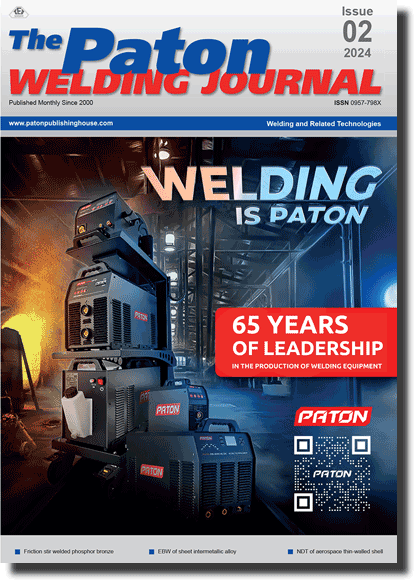| 2024 №02 (05) |
DOI of Article 10.37434/tpwj2024.02.06 |
2024 №02 (07) |

The Paton Welding Journal, 2024, #2, 33-40 pages
Effectiveness of unloading a section of NPS pipeline with a pipe wall thinning defect by mounting a band or welded sleeve
G.V. Vorona, O.V. Makhnenko, O.S. Milenin
E.O. Paton Electric Welding Institute of the NASU. 11 Kazymyr Malevych Str., 03150, Kyiv, Ukraine. E-mail: makhnenko@paton.kiev.uaAbstract
Formation of erosion-corrosion wear defects in NPS pipelines is one of the urgent problems of nuclear power engineering. At pipeline repair the defective section is cut out and a new pipe spool is mounted using welding, which is a rather labour-consuming process, and requires draining of the transported liquid. To prolong the service life, the defective pipeline section can be reinforced by mounting a repair structure, for instance a band or welded sleeve. In order to substantiate the rationality of application of reinforcing structures in pipeline repair, finite element analysis of the stress-strain state of the rectilinear pipeline section with a defect of erosion-corrosion wear under the impact of internal pressure was performed, as well as evaluation of the effectiveness of unloading the defective section in the case of application of a reinforcing structure of the type of a band or welded sleeve in repair. Analysis results showed the high effectiveness of application of such structures. Obtained results can be used in substantiation of introduction in the Ukrainian NPS of alternative technologies of repair of pipelines, predominantly technological ones, particularly in those cases when repair by traditional methods is not possible or rational for technical or economic reasons. 18 Ref., 2 Tabl., 9 Fig.
Keywords: NPS, pipeline, erosion-corrosion wear, wall thinning defect, reinforcing structure, band, sleeve, stress-strain state, ductile fracture, finite element method
Received: 02.10.2023
Received in revised form: 11.12.2023
Accepted: 30.01.2024
References
1. Ageiev, S. (2021) Methodology for assessing the allowable wall thicknesses of carbon steel NPP piping under erosion- corrosion wear. J. Nuclear and Radiation Safety, 3(91), 32-42, https://doi.org/10.32918/nrs.2021.3(91).042. Ozhygov, L., Mytrofanov, A., Krainyuk, E. et al. (2013) Operational wear of pipelines of senond circuit of WWER-1000 power units. Visnyk TNTU, 69(1), 55-62 [in Ukrainian].
3. Gribok, A., Vivek Agarwal (2015) Flow-Assisted Corrosion in Nuclear Power Plants. No. INL/EXT-15-36611-Rev000. Idaho National Lab. (INL), Idaho Falls, ID (United States).
4. Poulson, Bryan (2014) Predicting and preventing flow accelerated corrosion in nuclear power plant. Int. J. of Nuclear Energy, 2014, 423295. https://doi.org/10.1155/2014/423295
5. NEA (2015) CODAP Topical Report: Flow Accelerated Corrosion (FAC) of Carbon Steel and Low Alloy Steel Piping in Commercial Nuclear Power Plants. OECD Publishing, Paris.
6. Vorona, G.V., Ananchenko, M.S., Makhnenko, O.V. (2023) Automation of procedure for determination of acceptance of erosion-corrosion wear in NPP pipelines. Mech. Adv. Technol., 7(1), 113-121 [in Ukrainian]. https://doi.org/10.20535/2521-1943.2023.7.1.272443
7. Makhnenko, V.I., Velikoivanenko, O.A., Rozynka, G.F., Pivtorak, N.I. (2010) Improvement of method for estimation of the risk of fracture within the thinning zone on walls of main pipelines. The Paton Welding J., 5, 10-14 [in Russian].
8. Vengrynyuk, T.P. (2010) Restoration and strengthening of gas-and-oil pipelines. Prospecting and Development of Oil and Gas Fields, 2(35), 136-139 [in Ukrainian]. DOI: https://rrngr.nung.edu.ua/ index.php/rrngr/article/view/591
9. Jaske, Carl E., Brian O. Hart, William A. Bruce (2006) Updated pipeline repair manual. No. R2269-01R.
10. Repair of Pressure Equipment and Piping. An American national standard. ASME PCC-2-2018 (Revision of ASME PCC-2-2015).
11. (2019) МТ-Т.0.03.224-18 Procedure for determination of acceptable thicknesses of NPP pipeline elements from carbon steels subjected to erosion-corrosion wear. NAEK Energoatom [in Russian].
12. (1989) PNAE G-7-002-86. Norms of strength analysis of equipment and pipelines of nuclear power plants. Moscow, Energoatomizdat [in Russian].
13. Milenin, A., Velikoivanenko, E., Rozynka, G., Pivtorak, N. (2019) Probabilistic procedure for numerical assessment of corroded pipeline strength and operability. Int. J. of Pressure Vessels and Piping, 171, 60-68. https://doi.org/10.1016/j.ijpvp.2019.02.003
14. Timoshenko, S.P., Vojnovsky-Kriger, S. (1966) Plates and shells. Moscow, Nauka [in Russian].
15. Makhenko, V.I., Velykoivanenko, O.A., Milenin, O.S., Pivtorak, G.P. (2012) Computational assessment procedure of efficiency of couplings (bands) mounting in the zone of wall thinning of main pipeline. In: Problems of service life and safety of structures, constructions and machines. Kyiv, PWI, 15-17 [in Ukrainian].
16. Kravchenko, V.P. (2017) Increase of safety and cost effectiveness of NPP by control of service life of secondary circuit pipelines. Yadernaya i Radiatsionnaya Bezopasnost, 3, 25-29 [in Russian]. https://doi.org/10.32918/nrs.2017.3(75).04
17. (2011) GBN В.3.1-00013741-12:2011. Main gas pipelines, repair by arc welding in operating conditions. Kyiv, Ministry of Energy and Coal Industry of Ukraine [in Ukrainian].
18. Orynyak, I., Ageiev, S., Radchenko, S., Zarazovskii, M. (2015) Local limit load analytical model for thick-walled pipe with axial surface defect. J. of Pressure Vessel Technology, 137(5), 051204. https://doi.org/10.1115/1.4029523
Suggested Citation
G.V. Vorona, O.V. Makhnenko, O.S. Milenin (2024) Effectiveness of unloading a section of NPS pipeline with a pipe wall thinning defect by mounting a band or welded sleeve. The Paton Welding J., 02, 33-40.The cost of subscription/purchase order journals or individual articles
| Journal/Currency | Annual Set | 1 issue printed |
1 issue |
one article |
| TPWJ/USD | 384 $ | 32 $ | 26 $ | 13 $ |
| TPWJ/EUR | 348 € | 29 € | 24 € | 12 € |
| TPWJ/UAH | 7200 UAH | 600 UAH | 600 UAH | 280 UAH |
| AS/UAH | 1800 UAH | 300 UAH | 300 UAH | 150 UAH |
| AS/USD | 192 $ | 32 $ | 26 $ | 13 $ |
| AS/EUR | 180 € | 30 € | 25 € | 12 € |
| SEM/UAH | 1200 UAH | 300 UAH | 300 UAH | 150 UAH |
| SEM/USD | 128 $ | 32 $ | 26 $ | 13 $ |
| SEM/EUR | 120 € | 30 € | 25 € | 12 € |
| TDNK/UAH | 1200 UAH | 300 UAH | 300 UAH | 150 UAH |
| TDNK/USD | 128 $ | 32 $ | 26 $ | 13 $ |
| TDNK/EUR | 120 € | 30 € | 25 € | 15 € |
AS = «Automatic Welding» - 6 issues per year;
TPWJ = «PATON WELDING JOURNAL» - 12 issues per year;
SEM = «Electrometallurgy Today» - 4 issues per year;
TDNK = «Technical Diagnostics and Non-Destructive Testing» - 4 issues per year.


